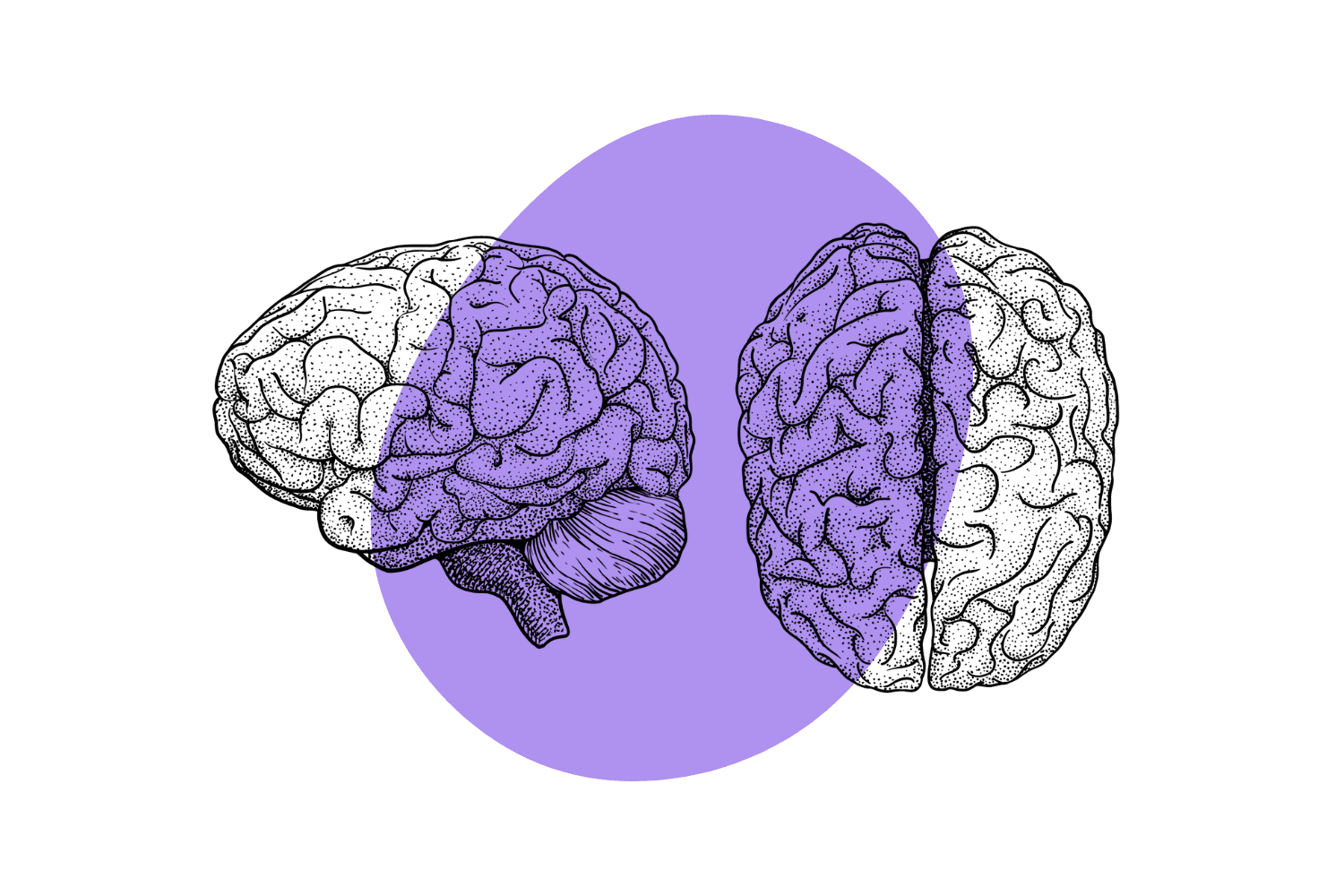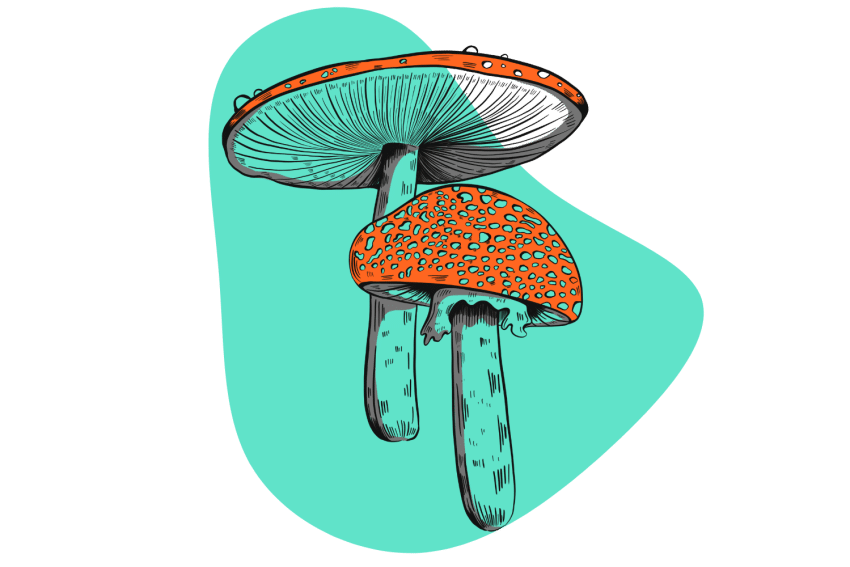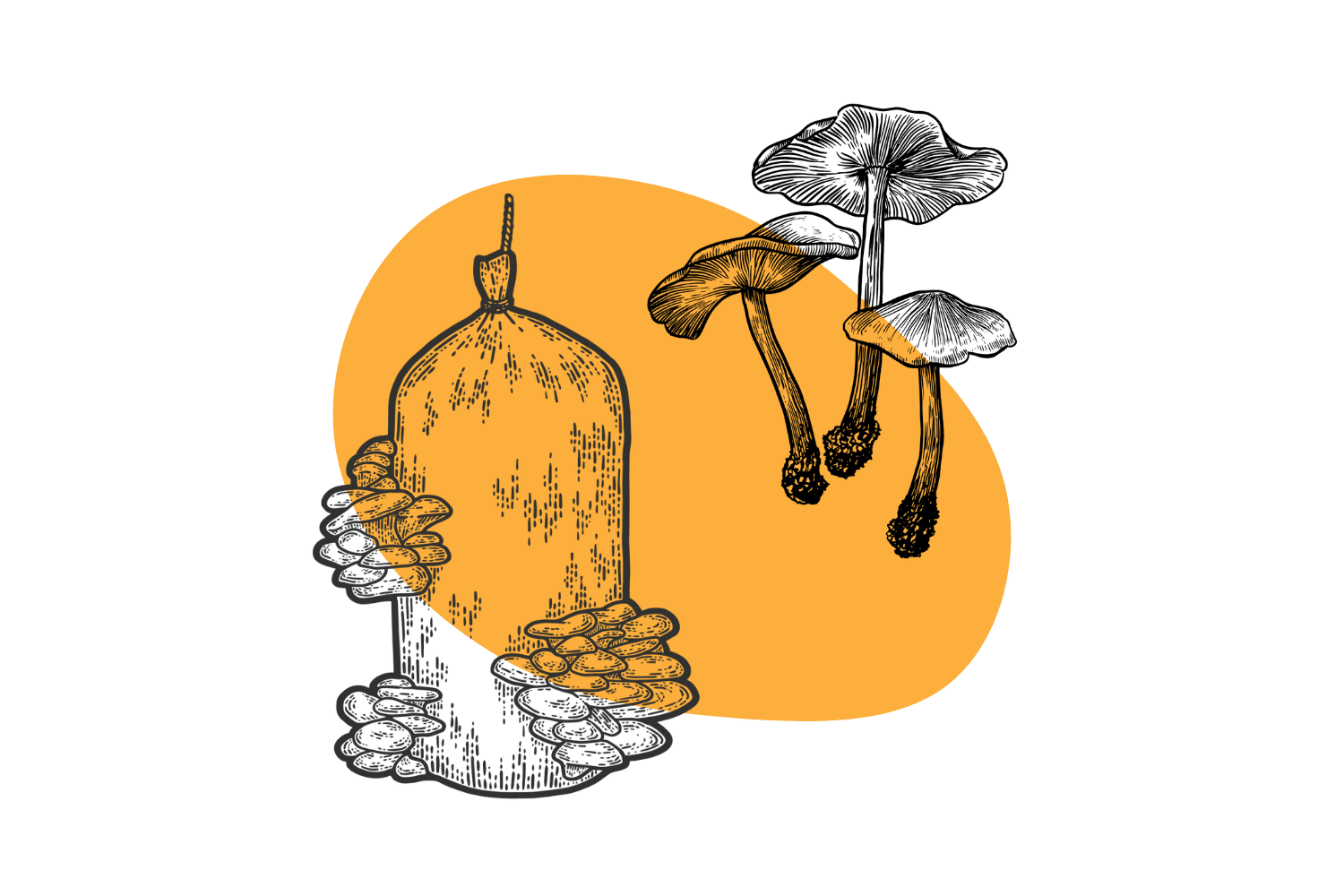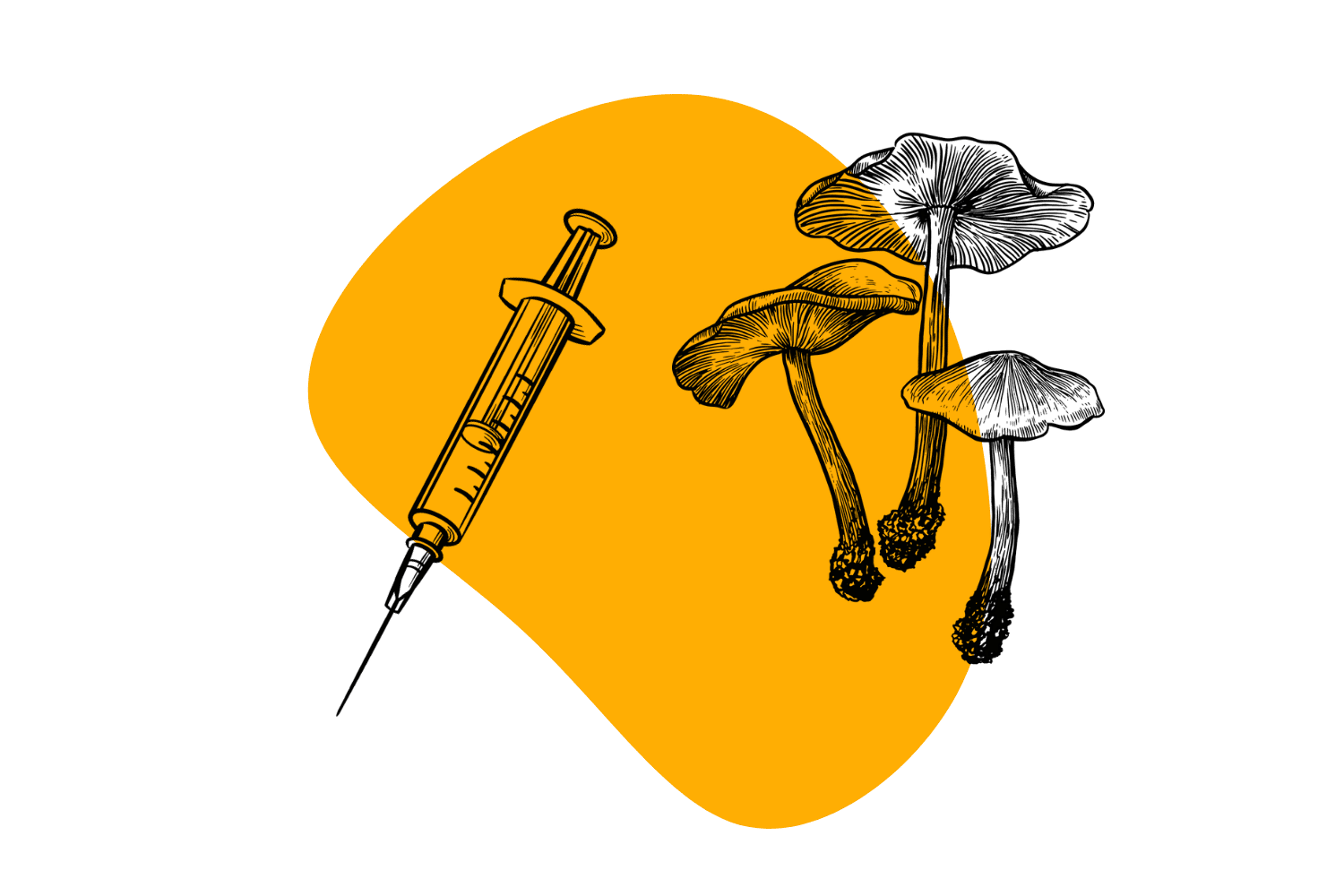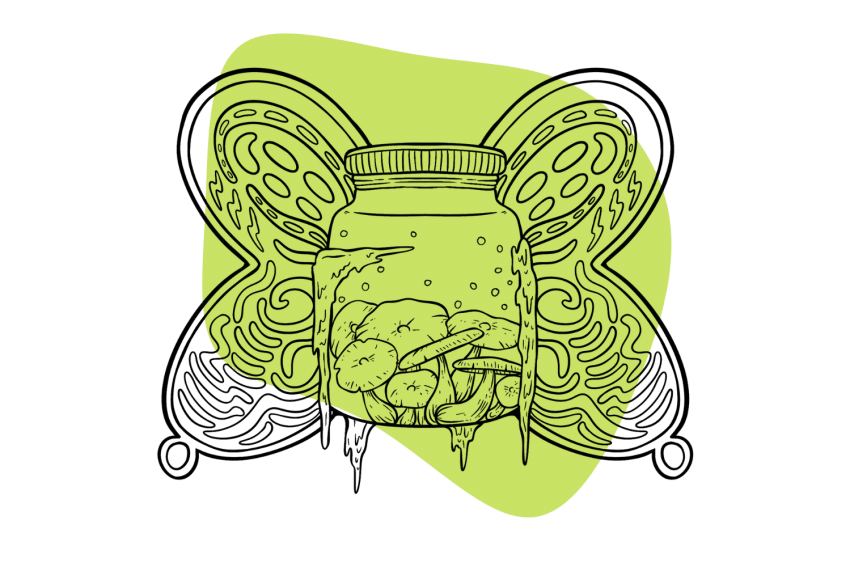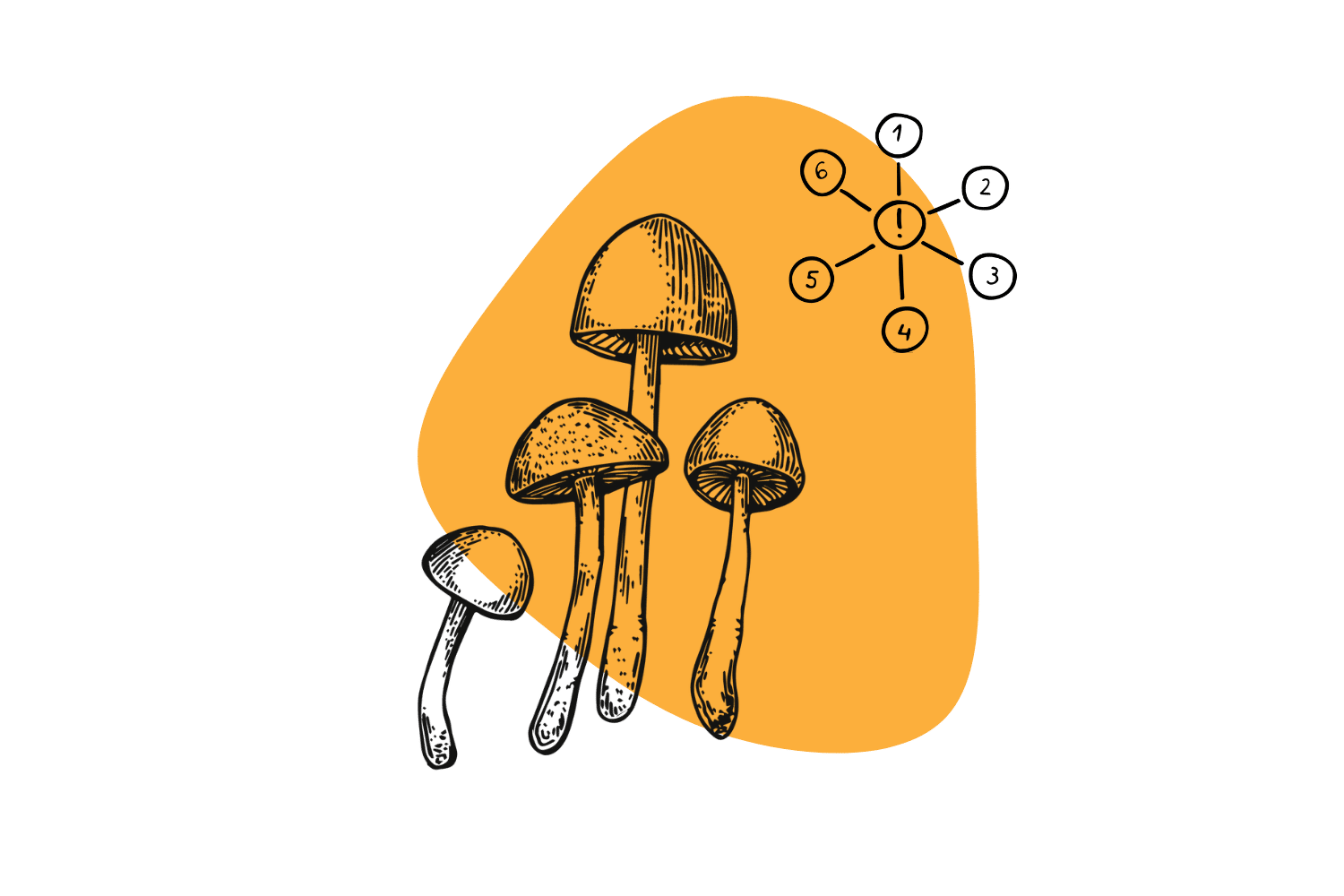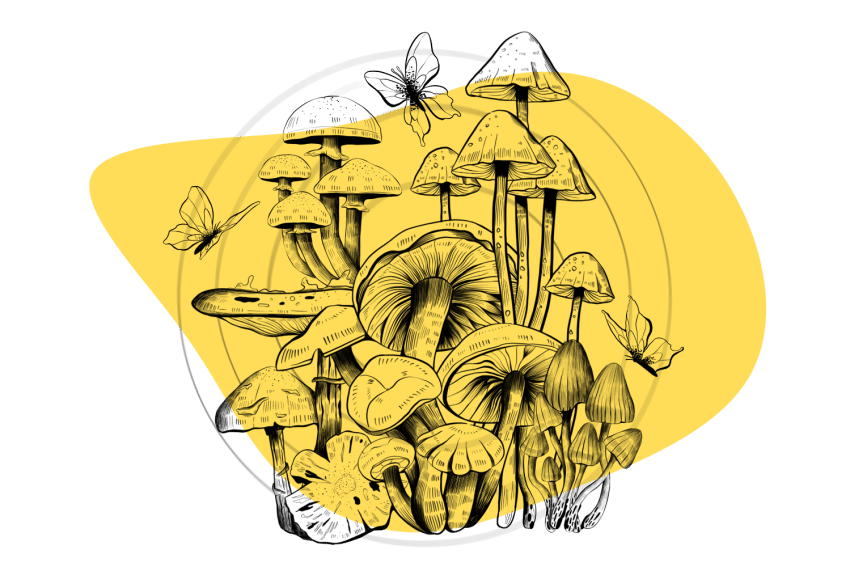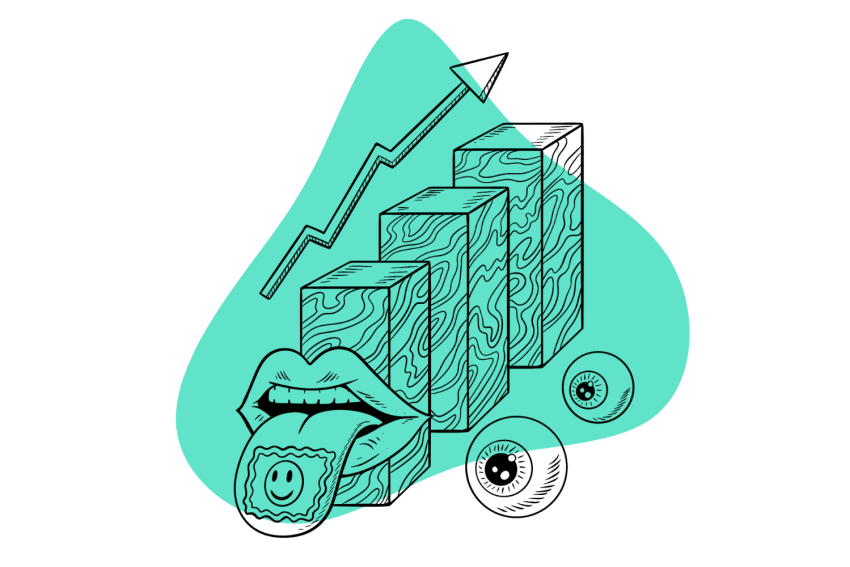Magic Mushrooms 101: Everything You Need To Know Before You Trip
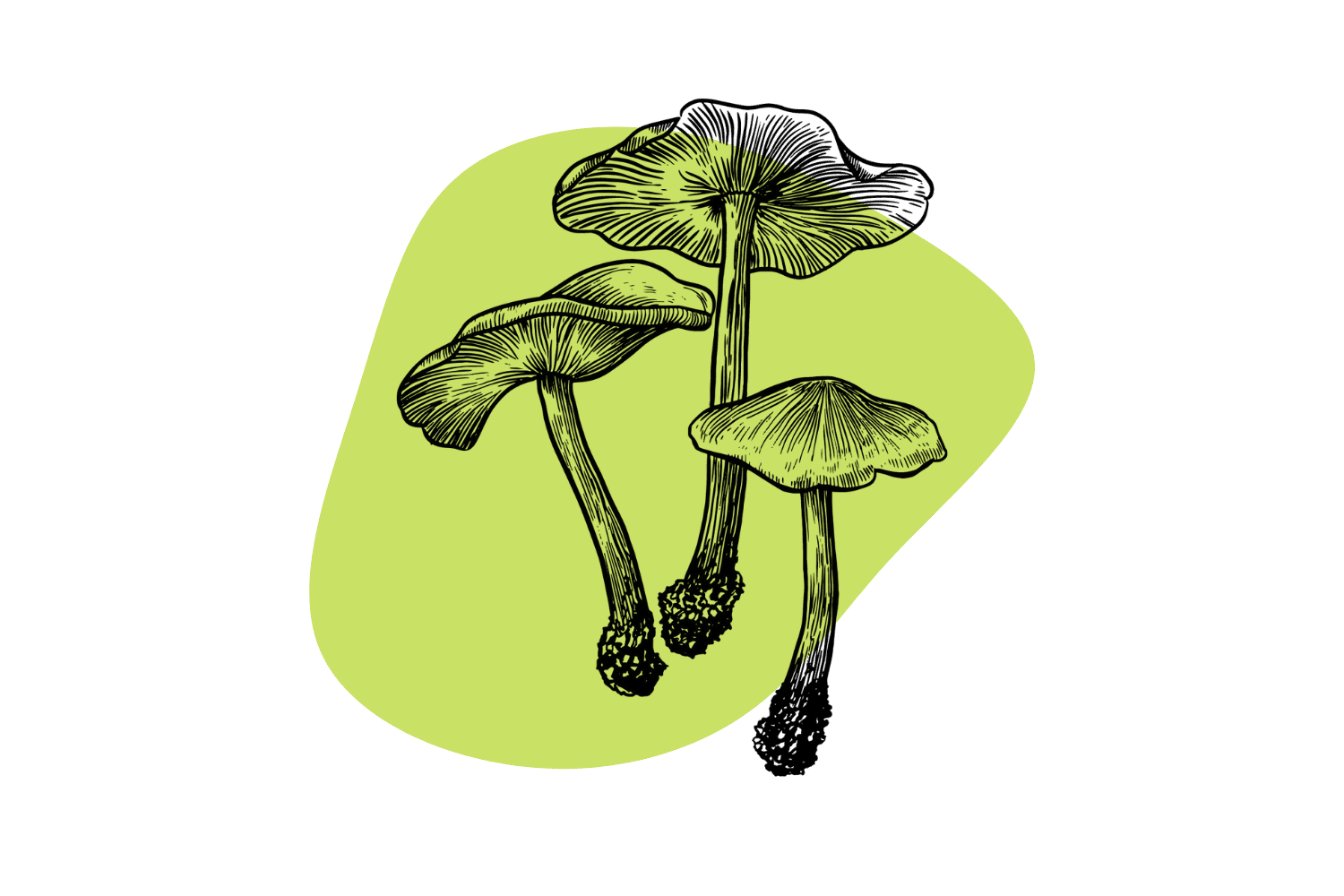
Magic mushrooms are used as a tool for self-growth, as well as treating legitimate medical conditions — such as depression, PTSD, existential anxiety, cluster headaches, and more.
Medical research on magic mushrooms has shown a lot of promise over the last few decades, and longstanding laws around the use of magic mushrooms are being revisited.
In this guide, you’ll learn everything you need to know about magic mushrooms — from start to finish.
What Are Magic Mushrooms?
“Magic mushroom” is an all-encompassing term for any species of fungi with psychoactive or hallucinogenic effects. They’re one of the most common psychoactive substances on earth.
There are over 200 different species of magic mushrooms — which can be found growing on every continent on earth except Antarctica.
Magic mushrooms contain two psychoactive alkaloids — psilocybin and psilocin. These alkaloids have the ability to interact with the serotonin receptors (5HT2A) — producing changes in the way we perceive sensory information (sound, vision, and touch).
Aside from changing sensory perception, magic mushrooms have a strong spiritual component. They’re used as a tool for self-discovery and spiritual experience. They’ve been used as a sacrament in virtually every region of the world in which they can be found — including South America, North America, Europe, Asia, and Australasia.
Medical research on magic mushrooms has seen a lot of breakthroughs in the last three years too. Magic mushrooms have been shown to offer substantial benefits in treating addiction, depression, anxiety, cluster headaches, and much more.
Magic Mushrooms: Specs & Technical Details
| Active Ingredients | Psilocybin & Psilocin |
| Level of Risk | Low |
| Street Names | Magic Mushrooms, Mushies, Shrooms |
| Most Common Side Effects | Anxiety, Digestive Upset |
| Duration of Effects | 4 – 6 Hours |
| Legality | Illegal or Decriminalized |
Trip Sitter Safe Trip Guidelines
- 🐍 I understand why psychedelics should be treated with respect
- ⚖️ I’m familiar with the laws for magic mushrooms in my country & state
- 🍄 I’m familiar and confident in the dose I’m taking (1–3 g for the first session)
- 💊 I’m not mixing any medications or other substances with magic mushrooms
- 🏔 I’m in a safe & comfortable environment with people I trust
- 🐺 One of the members of my group is responsible and sober (AKA a trip sitter)
- ⏳ I have nothing important scheduled for after the trip
- 🧠 I’m in a sound & healthy state of mind
- 📚 I’m familiar with the four pillars of responsible psychedelic use — set, setting, sitter, & substance.
- 🍄 I’ve properly identified the mushrooms I’m using — never wildcraft psilocybin mushrooms unless you’re 100% sure about the species you’re picking. There are poisonous lookalikes.
- ⏳ Know the timeline — the effects of magic mushrooms are going to last between 6 and 8 hours.
- 🙅♀️ Know when to avoid magic mushrooms — don’t take shrooms if you have underlying heart, neurological, or psychiatric disorders.
Are Magic Mushrooms Legal?
Magic mushrooms are illegal throughout most of the world. They’re classified as Schedule I in the United States, which makes them illegal to produce, possess, and use.
However, laws are rapidly evolving. Within the last 12 months, both Oregon and Washington, DC, decriminalized the use of magic mushrooms. North of the border, the province of British Columbia, Canada, silently decriminalized all psychedelic drugs — including magic mushrooms. Here, it’s easy to get magic mushrooms delivered.
These changes in legal restrictions are a representation of how public opinion about these psychoactive fungi is evolving.
With the recent New York Times bestseller from author Michael Pollan — How to Change Your Mind — and dozens of breakthroughs in medical research over the past five years, more people are becoming educated about magic mushrooms.
There’s no evidence thus far to suggest magic mushrooms pose any threat to society.
On the contrary, research on magic mushrooms suggests these mushrooms could offer a solution to some of society’s biggest issues — from drug addiction to depression — both of which have become epidemics in Western society.
Startups like MindMed and Field Trip are popping up in places like Canada and the United Kingdom that are centered around the medicinal use of magic mushrooms for treating psychiatric disorders.
Laws are rapidly evolving in this space. At the moment, psilocybin clinics are only allowed to offer services for end-of-life care, but laws are expected to change within the next 12-24 months.
→ Learn more about psychedelic-assisted psychotherapy (PAP)
Magic Mushroom Dosage Calculator
The easiest way to find the dose of magic mushroom is to use our dosage calculator below. Enter your weight, the desired level of effects (microdoses, standard psychoactive doses, and heroic doses), and the type of mushrooms you’re using.
If microdosing, the goal is to take around 10% of a psychoactive dose. For larger people, this could be as high as 200 mg; for smaller people, it could be as little as 50 mg. The average microdose is around 100 mg.
If the intention is to take a psychoactive dose, the average is usually either 2 or 3 grams.
Heroic doses should only be considered by people with a lot of experience using magic mushrooms and who have a good understanding of the fundamentals of the set, setting, and responsible psychedelic use.
Double-check the potency of the DXM you’re using, and look for the addition of other compounds such as acetaminophen which can cause severe liver-toxic side-effects at this dose.
Comparing the Effects of Magic Mushrooms By Dose
The dosages of magic mushrooms can be separated into three categories — each of which has completely different impacts and should be used for different purposes:
| Dosage Type | Dose (In grams of Dried Mushrooms) | What Is This Dose Used For? | Frequency Of Use |
| Microdose | 0.2–0.5 grams | • Boost focus • Improve concentration • Promote creativity • Enhance productivity • To become more in touch with emotions | Cycles can range from once every three days to 1 week on, one week off |
| Threshold Dose | 0.5 to 1 gram | • Enhanced creativity • Slight perceptual changes • Alterations in mood & empathy | Once every couple of weeks or less. |
| Psychoactive Dose | 2 to 5 grams | • To reset the default mode network (DMN) • For spiritual growth and exploration • As a treatment for psychiatric health problems | Once every couple of months maximum |
| Heroic Dose | Over 5 grams | • To reset the default mode network (DMN) • For medical applications (under the guidance of a professional) | This dose should never be attempted without professional guidanceOnce every couple of years |
Microdosing Magic Mushrooms
(Less than 0.2 grams)
Microdosing magic mushrooms is a popular practice these days.
It’s used as a form of nootropic (substances that increase focus and memory) to boost productivity and creative thought process.
This concept involves taking magic mushrooms at a sub-psychoactive dose (it won’t make you high) on an ongoing basis.
This practice was made famous after it came to light that a circle of Silicon Valley CEOs and executives were using microdoses of magic mushrooms to be more productive and improve higher cognitive reasoning and thought.
What Does a Microdose Feel Like?
Microdoses of magic mushrooms (below the psychoactive threshold) produce a sense of focus and increased creativity.
The effects are strongest on the first day but gradually become more subtle the more you use them. This is because the body quickly develops a tolerance to the psychoactive effects of the mushrooms — but this doesn’t mean they’re not offering any benefits.
Some people won’t experience any perceptual or physical changes, even with the first dose.
The goal of using microdoses is to achieve a higher level of focus and productivity over time. They’re used to assist in developing new habits and routines and achieve a better grasp on emotional and interpersonal connections.
The first few days of taking a microdose can result in some mild perceptual changes — such as slight waviness in vision (especially when looking at a digital screen), tingly sensations throughout the body, and changes in depth-perception in the hands and limbs.
Microdoses can also cause some mild changes in mood (either extra social or slightly antisocial), a feeling of mild euphoria, and alterations in workflow or focus.
Over the course of a few days, you should notice most of the perceptual changes disappear. You should still experience the benefits of focus, concentration, and creativity.
Threshold Dose (AKA Low Dose)
(0.5 – 1 gram)
The threshold dose refers to the minimum amount of a substance needed to produce noticeable psychoactive effects.
This dose isn’t strong enough to produce significant perception changes or ego death experiences — but can make everything feel a little bit “different” or “sparkly”.
People who use this dose may feel a tingly sensation in their stomach, some mild perceptual differences (such as seeing subtle “vibrations” in their vision, enhanced tactile and audio perception). Many people find they’re able to pick out new layers of sounds in the music they’ve listened to many times before, and some experience a dramatic uptick in mood and empathy towards others.
The threshold dose is sometimes used to facilitate the creative process. It makes you feel more open-minded and creative without adding too much of the psychedelic effects that can interfere with the creative process itself.
Standard Psychoactive Dose
(2 – 5 Grams)
The standard psychoactive dose (2 – 5 grams) produces much stronger effects. At this dose, the full extent of the psychoactive effects of magic mushrooms becomes apparent.
This is the most common dosage range used for therapeutic doses in a clinical setting. It’s also the most common dose people use when taking mushrooms for the purpose of self-growth and introspection.
T-0: Taking the Mushrooms
From the moment you take the mushrooms, the time begins. This is T-0.
Around T-30 (30 minutes after taking the mushrooms), you’ll start to feel some mild effects from the mushrooms. The effects usually begin with a feeling of having “butterflies” in the stomach, which gradually transforms into sensations in the arms and legs over the course of an hour.
T-60: 1 The Onset
At T-60 (1 hour in), the effects will be much more apparent.
Mushrooms have a much stronger “body high” component compared to LSD or other psychedelics, so you should expect to feel some “trippy” sensations throughout the body. It’s common for people to feel like their arms and legs are longer or shorter than normal, your hands may look and feel different, and you may even feel as though your limbs are not your own (strange, I know, but this sensation is hard to describe with words).
Learn More About the Shroom’s Effect Timeline Here.
T-90: Peak Effects
By T-90 (an hour and a half), the mushrooms should be approaching their peak effects, which will then last for 1 – 2 hours before gradually decreasing over the course of about 3 hours). At this time, you’ll experience moderate to strong visual distortions and hallucinations. These hallucinations are based on real-life objects and people — you won’t be seeing any cartoon unicorns or anything like that. The high you feel at this dose doesn’t remove you from reality. You’ll remain cognizant of the real world.
The visuals can become very intense. Objects may be morphing and changing, patterns begin forming into geometric shapes, and objects that may have otherwise been unremarkable may appear to have much greater significance — such as a knot in a tree or a spec on the wall.
Internally, the effects of magic mushrooms at this dose can become confusing and chaotic. Making decisions becomes much more difficult, and you easily lose focus on what you’re doing. You may feel exceptionally introspective and experience realizations to thoughts or concepts that are difficult to grasp while sober — such as the meaning of life and existence.
Mushrooms can induce deep philosophical thinking at this dose.
T-180: Returning Back To Reality
Around T-180 (about 3 hours into the trip), you may start to notice the effects starting to fade. At this point, the effects of the mushrooms come in “waves.” At times they’re very strong, followed by periods of diminished effects and return to near-normal thought processes. This can go on for a couple of hours, each wave peaking at a lower intensity.
T-300: The Comedown
By T-300 (5 hours into the trip), you’ll be in a state of relaxation. The experience you just went through will leave you with a lot to think about. You’ll feel relatively relaxed and low-energy. You’ll still be feeling the effects of the mushrooms, but much of your regular thought structure will be back by this time. The effects will continue to wear off gradually over the next couple of hours.
Heroic Doses of Magic Mushrooms
(More than 5 grams)
The heroic dose is a concept made popular by famous leaders in the psychedelic space such as Paul Stamets, Timothy Leary, Michael Pollan, and brothers Terance McKenna & Dennis Mckenna. It involves taking a high dose (over 5 grams) of magic mushrooms or pure psilocybin.
A “heroic dose” should never be attempted by anybody without proper guidance from a professional, and certainly never alone. A trip sitter or trained psychotherapist is a necessary step when using high doses of any psychedelic substance.
Heroic doses are used to induce powerful hallucinations, reset of the default mode network (DMN), and ego death.
Check out this interview with Dennis McKenna on heroic doses of magic mushrooms.
What Does a Heroic Dose Feel Like?
Heroic doses of magic mushrooms start out with the same progression of the standard psychoactive dosage range. The difference only becomes apparent around 90 minutes after using the mushrooms.
High doses can produce strong dissociative states. While it’s rare for even large doses to cause a complete decoupling with reality in the way other psychedelics like DMT or Ibogaine can produce, high doses often make users feel as though they’re outside their own bodies.
A common experience involves the perception that you’re standing “behind yourself”, watching your body move autonomously through the world beyond your control.
You experience intense visions and hallucinations — some of which can be terrifying at times. Bad trips are much more common at this high dose, which is why it’s important that you have experience with using these mushrooms before even attempting this dose. The intensity of visions can become similar to drugs like DMT or ayahuasca at this dose.
The total duration of effects will be slightly longer when using high doses compared to standard psychoactive doses. The average duration of effects for this dose is around 7 hours.
Also see: Can Orange Juice Really Improve a Psychedelic Trip?
How to Take Magic Mushrooms
There are many different ways to use magic mushrooms. The most common method is to simply eat a few of the dried mushrooms directly, but you can also make mushroom tea, make them into mushroom chocolates, or diffuse them into honey.
Here are seven methods for consuming magic mushrooms:
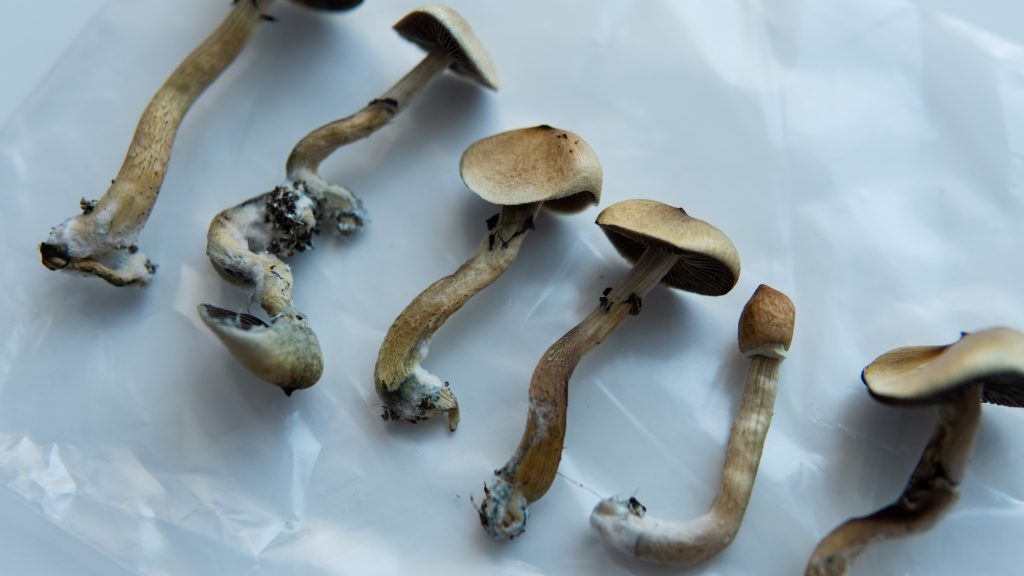
Eat The Mushrooms Whole
This is the most common method of using mushrooms around the world. You can eat both fresh and dried mushrooms directly.
I’m going to be completely honest — magic mushrooms don’t taste great. Fresh mushrooms are a little bit better, but not by much. The easiest way to use them is to just knock them back and follow up with some sort of chase to mask the taste (if needed).
Related: 8 Things to Do After Eating Magic Mushrooms.
Some people will add their shrooms to food to mask the flavor. Some effective meals for this are pizza or pasta.
The only rule here is that you should never heat the mushrooms in any way. Heat will destroy the psilocybin and remove its psychoactive effects. Always add the mushrooms at the very end if you’re trying to mask them in food.
Before you start digging into your bag of mushrooms, it’s important to weigh out the correct dose using a scale. This is an important step to ensure you’re using the right dose each time and avoid the risk of taking too much.
What’s the Dose For Fresh Mushrooms?
If using dried mushrooms, stick to the dosages listed above (0.2 grams or less for microdose and 2 – 4 grams for standard dose).
For fresh mushrooms, the dose is much higher to account for the added water weight. Mushrooms contain as much as ten times higher while fresh than dried. So you should multiply the dried dose by 10 to find the equivalent dose in fresh mushrooms.
For example, the standard 3-gram dose of dry mushrooms is equivalent to about 30 grams of fresh.
Eat The Mycelium (Truffles)
Truffles refer to the underground portion of the mushroom — called the mycelium.
What we think of as a “mushroom” is simply the reproductive organ of the fungi. The organism itself lives below the ground in the form of a thick mat of fibrous “threads” called mycelia. These threats penetrate the mushroom’s source of food to break it down and turn it into energy.
The mushrooms that appear above the soils are sent up seasonally for the purpose of spreading their spores to form new organisms.
In some parts of the world, magic mushrooms are illegal, but mycelium (truffles) are not. If you order magic mushrooms at a coffee shop in Amsterdam, for example, you’re going to get a bag of truffles rather than mushroom fruiting bodies.
Truffles contain the active psilocybin and psilocin as well but in lower concentrations. Additionally, it’s nearly impossible to separate all the growing substrates from the mycelium, which adds to the overall weight of the truffles.
The approximate equivalent of a magic mushroom truffle is about 2.7 times the dose of the mushroom caps. This means our 3-gram example dose is equivalent to about 8 grams of truffles.
You can use truffles the same way you would use dried mushrooms. Eat them directly, mix them into capsules, or make tea.
Make Mushroom Tea
Mushroom tea is an attractive option because it helps eliminate the bad taste of the mushrooms and reduces the chances of digestive discomfort — which some people experience when eating dried mushies.
The most important thing to remember when making mushroom tea is to avoid overheating the mushrooms. Heat will destroy the active ingredients.
If you have a variable temperature kettle, set the temperature to around 70ºC (158ºF). If you don’t have a variable temperature kettle, keep a close eye as the water heats up and remove from the heat as soon as bubbles start to form at the bottom.
Add the mushrooms to a teapot or tea bag and let it infuse for several minutes.
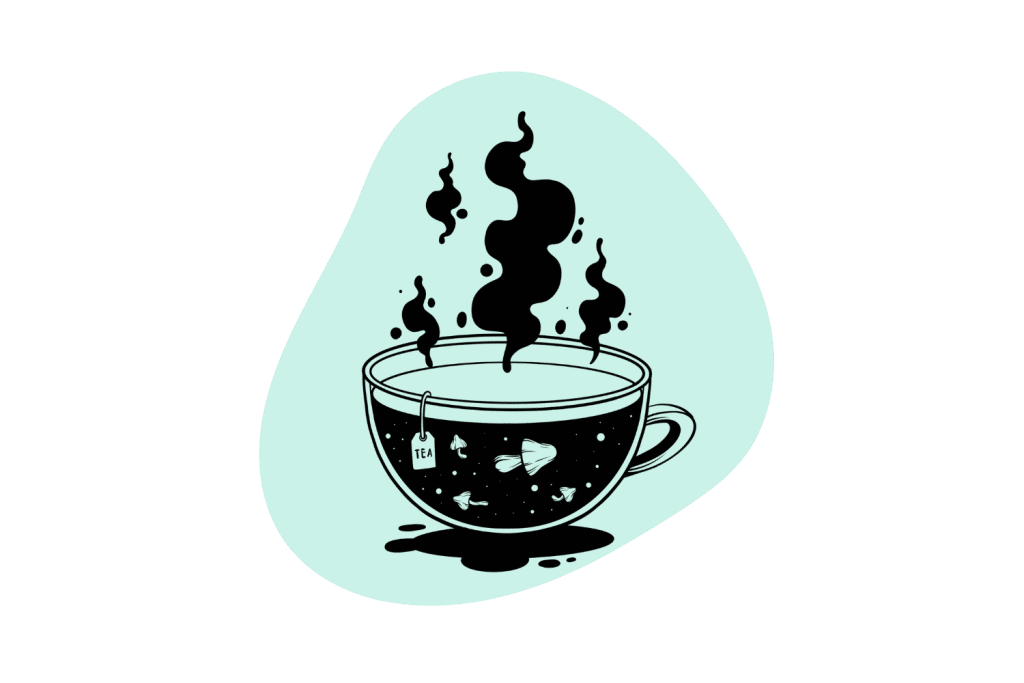
You can continue to reuse the mushrooms as much as you want. In order to get the full dose, you may need to do a couple of washes with new water.
This isn’t the most efficient way of using magic mushrooms because the active ingredient, psilocybin, doesn’t dissolve very efficiently in water. For this reason, you may need to increase the dose used by about 10% to offset this.
Also see: How to Take Magic Mushrooms with Lemon Tek.
Make Psychedelic Mushroom Honey
You can make psychedelic honey yourself by covering dry mushrooms in honey for several weeks. The psilocybin will gradually diffuse from the mushrooms into the honey. From here, you can simply eat the honey raw, add it to a tea (not too hot, remember), or spread it over toast or another source of food.
The hardest part when making psilocybin honey is getting the potency right.
It’s a good idea to aim for a ratio of about 1:10 — meaning that for every gram of magic mushrooms, you’re adding about 10 milliliters of honey.
It also helps to chop the mushrooms up into smaller pieces using a coffee grinder or blender. Avoid powdering the mushrooms though it will be difficult to strain later.
Let the honey and mushrooms sit for at least three weeks to ensure as much of the active ingredients can diffuse into the honey as possible. Give the jar a shake every now and then to mix it up.
When it’s ready, you can use the honey as-is or run it through a cheesecloth to filter out the mushroom bits (totally optional).
Make Mushroom Chocolates
Magic mushroom chocolates are often referred to as “truffles,” — but don’t get this mixed up with the mycelium bodies which were covered above that also goes by the name truffles.
Chocolate truffles are made by mixing the dry mushroom powder into a chocolate base. They’re popular as a way to mask the flavor of the mushrooms and make them easier to consume.
It’s also important to add the mushrooms while the truffles are cooling. Melt the chocolate separately, pour them into your chocolate molds first — and then mix the mushrooms into the chocolate. This ensures the mushrooms are never heated up — which destroys the active ingredients.
Make Scooby Snax (Capsules)
Mushroom capsules are the most common method of consumption for microdoses because it helps standardize the dose and allow you to add other ingredients to the mix.
The term “Scooby Snax” is used to describe a capsule formulation involving a small dose of magic mushrooms (less than 200 micrograms), align with other helpful ingredients such as ginger, L-theanine, L-tyrosine, 5-HTP, caffeine, or other ingredients.
You can get creative when making scooby snax, depending on what you’re looking to achieve. There are all sorts of recipes available online.
You can also make scooby snax capsules for standard psychoactive doses — just keep in mind you’ll likely need to take a few capsules at a time to reach the dose. A standard capsule holds a maximum of about 400 micrograms of dried mushroom powder on its own. Once you account for the other ingredients in the mix, this dose is even lower.
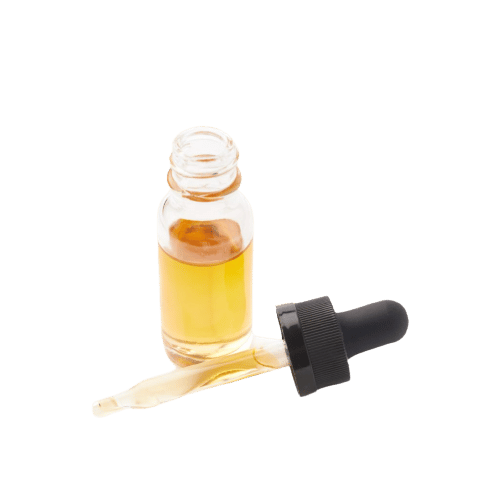
Take Pure Psilocybin Concentrate
Most of the medical research on psilocybin and magic mushrooms uses a pure form of psilocybin given in the form of a capsule or injection.
While this is much less commonly used by the public, it remains a good option if you have access to pure psilocybin or psilocin.
The dose of pure psilocybin for a standard psychoactive dose is between 10 and 25 mg of pure psilocybin.
How Do Magic Mushrooms Work?
Magic mushrooms work by mimicking the effects of serotonin — one of the brain’s most important neurotransmitters. Serotonin is involved with the regulation of mood, memories, focus, creativity, sexual arousal, and much more.
The active ingredients in magic mushrooms — psilocybin and psilocin — share a similar structure to serotonin. This allows them to interact with specific serotonin receptors located in various regions of the brain.
Most of the effects of magic mushrooms come from psilocin rather than psilocybin. Psilocybin needs to be metabolized (converted) by the liver into active psilocin before it can produce any effects.
Psilocin & The 5-HT1A Receptors
Activating this receptor doesn’t have nearly as strong of an effect on our perception, but it does interact with other parts of the body — such as heart rate and blood pressure.
This receptor is thought to be the primary mechanism involved with the anti-anxiety benefits of magic mushrooms.
Psilocin & The 5-HT2A Receptors
Most psychedelics work through the same mechanism — activation of the 5HT2A and 5-HT2C receptors.
The 5HT2A receptor is a subgroup of serotonin receptors (there are several) ranging from 5HT1 through to 5HT7 — each with a few subtypes referred to as type A, B, or C.
Psilocin interacts with several of these receptors, producing changes in mood, autonomic processes like heart rate, pupil dilation, and more. However, it’s this 5-HT2A receptor specifically that accounts for the majority of the psychoactive effects from the compound.
Activating these receptors results in changes in visual and auditory perception, mental stimulation, mood, memory, and more.
Psilocin & 5-HT2C Receptors
This is the second target for most psychedelic compounds — including magic mushrooms, LSD, DMT, and mescaline.
These receptors are responsible for inhibiting dopamine and norepinephrine release in certain parts of the brain. This effect is thought to contribute to the anti-anxiety, mood-balancing, and appetite-suppressing effects of magic mushrooms.
Activation of these receptors causes a change in the visual cortex of the brain.
Are Magic Mushrooms Safe?
Magic mushrooms can cause short-term psychological distress in the form of a bad trip. It’s been known to cause bouts of anxiety and paranoia while under the influence.
With that said, with proper care and mental preparation, the chances of experiencing a “bad trip” on magic mushrooms can be dramatically reduced.
The risk of physical harm from magic mushrooms is exceptionally low, and there has never been a single reported death from a magic mushroom overdose to date.
Researchers have been studying the effects of magic mushrooms for over 60 years now. Several large clinical trials involving high doses of magic mushrooms or pure psilocybin have all reported no lasting health effects following the trials [3, 4].
One of the best ways to assess the toxicity of a substance is to look at the LD50 — which refers to the “lethal dose” of a substance. LD50 is determined by giving animals (usually mice) increasingly higher doses of a compound until 50% die from an overdose.
This type of study is unethical — there’s no doubt about it — but it does give some useful insight into the toxicity of a particular compound.
Researchers searching for the LD50 for psilocybin noted exceptionally high doses compared to other compounds. The LD50 data for psilocybin is reported to be as high as 280 mg/kg [5].
To put this into context, this is roughly 1000 times the standard psychoactive dose of magic mushrooms. You would need to eat roughly 3500 grams of magic mushrooms before it becomes life-threatening.
This dose is completely unrealistic and likely impossible to achieve. 3500 grams is a lot of mushrooms.
With that said, there are some unwanted side effects that can occur while using magic mushrooms. All of these effects are short-term side effects only and resolve once the mushrooms wear off.
Side Effects of Magic Mushrooms
- Anxiety & paranoia
- Dilated pupils
- Fatigue or drowsiness
- Headaches
- Increased heart rate & blood pressure
- Lack of coordination
- Muscle weakness
- Nausea & stomach discomfort
Can Psilocybin Cause Seizures?
Yes, on rare occasions, psilocybin has been found to trigger seizures.
This side effect is extremely rare and much more likely to happen in people with existing seizure disorders. This is one of the reasons why it’s so important to have a trip sitter nearby to call for help or protect you from injuring yourself should you experience a seizure.
Can Psilocybin Cause Psychosis?
Yes, psilocybin can trigger psychosis in susceptible individuals.
It’s important to discuss your desire to use magic mushrooms with a psychiatrist if you or a close family member have been diagnosed with any mental health disorders.
The Real Danger Of Magic Mushrooms: Misidentification
Magic mushrooms themselves have been proven time and time again to be non-toxic — but there’s another hidden danger with using these mushrooms that many people don’t think about — misidentification.
Most psilocybin-containing species of mushrooms have a very unremarkable appearance. They’re one of the millions of small brown mushrooms found growing in forests and pastures around the world.
Many of the lookalike species for these mushrooms are toxic. It takes keen attention to detail and a fair bit of technical understanding to be able to safely differentiate magic mushrooms from other species found in the wild.
Every now and then, a story pops up involving someone who misidentifies edible mushrooms and ends up in the hospital. It’s just as common with wildcrafting gourmet edible mushrooms as it is for magic mushrooms.
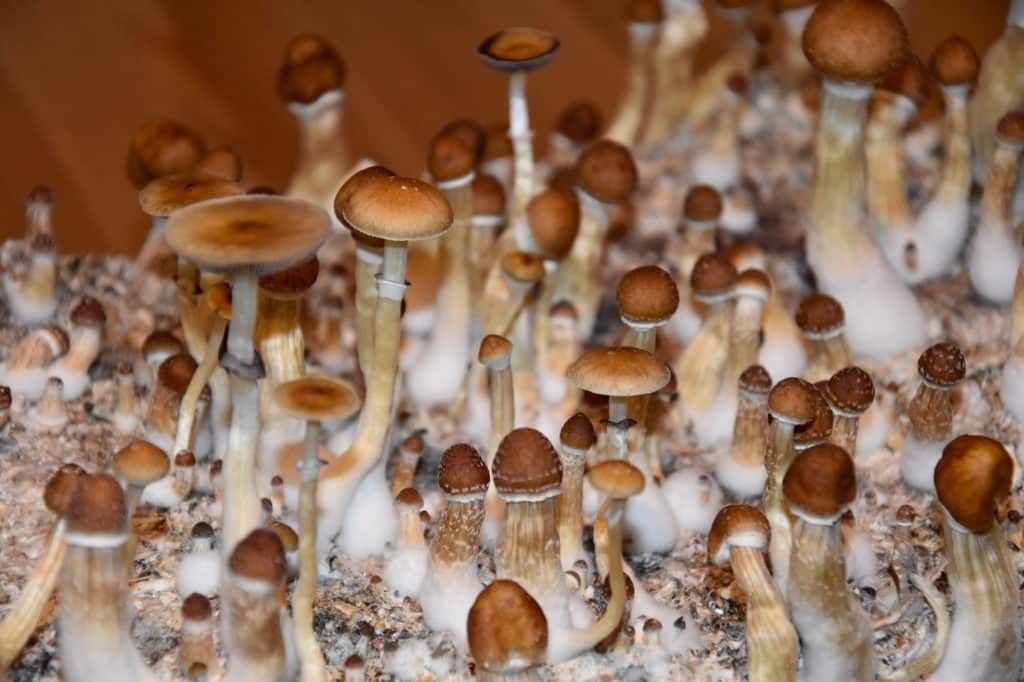
The bottom line here is that, while tempting, you should leave wildcrafting magic mushrooms to the experts. It’s okay to go hunting for magic mushrooms in the wild, and it can be a fun Sunday activity on its own, but you need to be 110% confident in your mushroom identification skills before you should even consider eating them.
When to Avoid Magic Mushrooms
Despite the high level of safety for magic mushrooms, there are a few situations where they should be avoided altogether.
- If you’re taking antipsychotic or antidepressant medications
- If you’ve been diagnosed with a heart condition
- While under the influence of alcohol or other drugs
- If you or a close family member has a history of psychiatric disorders (like schizophrenia or psychosis)
- If you’re unable to find a safe and comfortable place to use the mushrooms
- While in the presence of people you don’t trust
What Are The Health Benefits of Magic Mushrooms?
Magic mushrooms offer much more than a psychedelic afternoon. They offer legitimate health benefits — backed up through large-scale clinical trials and decades’ worth of research.
Research began back in the 1960s. Right away, research started showing improvements in psychiatric conditions such as schizophrenia, depression, addiction, and existential anxiety.
Today, research on magic mushrooms and other psychedelics is at its prime — there are dozens of studies published on the therapeutic applications every year.
Benefits of magic mushrooms that have been confirmed through medical research:
- Alleviates or prevents cluster headaches & migraines
- Reduces cravings & addiction to drugs, alcohol, & cigarettes
- Supports creative thought & focus (microdoses)
- Alleviate existential dread & anxiety
- Improve symptoms of PTSD, generalized anxiety, & social anxiety disorders
- Improves chronic depression & other mood disorders
- Alleviates symptoms of obsessive-compulsive disorder (OCD)
Outside of these benefits, there are a lot of anecdotal reports on the use of magic mushrooms for other conditions and applications as well.
Benefits that have not yet been confirmed through research:
- Alleviates symptoms of ADD & ADHD
- Alleviates migraine headaches
- Reduces symptoms associated with premenstrual syndrome
- May relieve shingles pain
Magic Mushrooms for Cluster Headaches
A cluster headache is similar to a migraine but differentiates in its frequency and duration. Cluster headaches come and go several times throughout the day; each experience lasting 15 minutes to 2 hours at a time. Migraines tend to last much longer and only come on once per day or less.
Cluster headaches can cause significant amounts of pain. One of the common names for this condition is “suicide headaches” because the pain is so great it can leave sufferers contemplating suicide at times.
Research on the effects of psilocybin on cluster headaches is still in its infancy — but the results published so far are very promising.
The team at Clusterbusters.org published the results of a survey they sent out to their readers in 2015. This project was formed after the founders discovered evidence that compounds like LSD had the potential to treat cluster headaches — a condition with a notoriously poor prognosis for treatment.
The results of this study were based on the self-reported data of 496 cluster-headaches sufferers (diagnosis confirmed by neurologist) [6].
The study reported that psilocybin from magic mushrooms was the most effective for preventing cluster headache attacks overall (33.7%).
This was followed by the pharmaceutical medication verapamil (16.6%), LSA (16.1%), steroids (15.1%), LSD (6.5%), and vitamins (3.5%).
Magic Mushrooms for Depression
One of the most promising therapeutic benefits of magic mushrooms is in the treatment of chronic depression.
A study published by the Beckley Foundation involving 12 patients with severe treatment-resistant depression gave patients either 10 or 25 mg of pure psilocybin to explore the impact on symptoms [9]. The study noted a significant reduction in depression scores following the study, which remained intact six months later during a follow-up examination.
There are two methods of using magic mushrooms for the purposes of managing depression:
- Microdoses taken over long periods of time
- One or two sessions of a psychoactive dose
One of the ways psilocybin is thought to work for depression comes down to its effects on the 5HT serotonin receptors. Psilocybin has been shown to interact with the 5-HT1A, 5-HT1D, 5-HT2A, and 5-HT2C receptors — several of which are the targets for common antidepressant medications (SSRIs) [7].
For microdosing, the idea is that steady, consistent doses of psilocybin have a downregulating effect on the serotonin receptors over time. Studies have shown that increased binding activity at the serotonin receptors (primarily 5-HT2A) plays a role in depression [8].
For microdosing (psychedelic experience), a similar effect on the serotonin receptors is taking place here as well, but there’s another layer to the benefits.
Psychedelics like psilocybin, LSD, LSA, DMT, and mescaline are all thought to “reset” a system in the brain called the default mode network (DMN) — which we’ll explore in more detail below.
The DMN is involved with our image of self and self-worth — and thought to play a major role in the development of depression. Brain imaging studies have shown psilocybin is able to “reset” and “restructure” the DMN in a way that makes the mind less susceptible to depression and anxiety [1].
Magic Mushrooms for Anxiety
Studies involving the use of psilocybin-containing mushrooms have been ongoing since the 1960s. There have also been thousands of anecdotal reports of users eliminating or dramatically reducing their anxiety symptoms with the help of psychoactive mushrooms over the past 60 years.
More recently, there have been a couple of high-profile clinical studies on the use of magic mushrooms (and related indoleamine compounds) for the treatment of anxiety disorders.
In 2011, a study explored the effects of psilocybin on terminally ill cancer patients diagnosed with acute stress disorder, generalized anxiety disorder, or adjustment disorder with anxiety (as per the DSM-IV protocol) [10].
Each patient had two sessions — one with 0.2 mg/kg psilocybin, the other with a placebo (niacin) — each session was several months apart.
This study found that the psilocybin dose resulted in a significant reduction in anxiety scores in the majority of patients — which were sustained at the 6-month follow-up period.
Another study (2016) compared the impact of microdosing magic mushrooms versus psychoactive dosing on cancer patients diagnosed with both depression and anxiety [11]. This study noted that psychoactive doses had a much greater improvement in depression and anxiety scores than the microdose group.
The only problem with this study is that researchers failed to test the long-term impact of microdosing. Most experts agree, the benefits of microdosing stem from long-term, ongoing use rather than a one-off treatment.
Related: The Role of Magic Mushrooms In Palliative Care (Existential Anxiety)
Magic Mushrooms For Addiction
Most of the research on the use of psychedelics for treating addiction revolves around LSD (older research focus) or ayahuasca (newer research focus). Magic mushrooms are often grouped under these studies because of their ability to interact with the same receptors — the 5HT2A serotonin receptors.
A study published in 2015 explored the impact of psilocybin in the treatment of alcohol addiction [12]. This study involved two sessions involving doses of either 0.3 or 0.4 mg/kg of pure psilocybin (equivalent to around 4 or 6 grams of magic mushrooms).
Following the treatment, researchers reported a dramatic down-tick in alcohol consumption and cravings among the study participants that were maintained at the conclusion of the follow-up period 36 weeks later.
Another study looked at the impact of psilocybin on another common addiction — tobacco [13]. This study gave patients a dose of either 20 or 30 mg of pure psilocybin per 70 kg of body weight (equivalent to around 3.5 – 5 grams of dried mushrooms).
At the conclusion of this study, researchers reported an incredible 80% of patients were able to quit smoking by the end of the six-month study period. To put this into perspective, the standard interventions involving pharmaceutical medications have an average quit-rat of just 35%.
Magic Mushrooms Microdosing For Focus, Concentration, & Creativity
Very often people seek microdoses of magic mushrooms for the purpose of improving focus and concentration, creativity, and the ability to solve difficult problems.
This practice became famous after it came to light that many of the successful CEOs and executives working for tech companies in Silicon Valley were using microdosing to be more efficient with their work.
There has yet to be any official studies exploring this effect, but a company called MindMed is currently recruiting for a phase II clinical trial to explore a similar compound — LSD — to assess its effects on focus and concentration.
A man named Dr. James Fadiman has been collecting informal data on this effect for the past couple of years, which he recently published in a paperback in 2019 [14]. His study aimed to create a protocol for microdosing magic mushrooms and LSD to eliminate some of the variables with user reporting. He then asked users to submit their anecdotal reports after following his protocol.
Dr. James Fadiman’s magic mushroom microdosing protocol:
- Dose: 0.4 grams psilocybin mushrooms
- Dosing Schedule: dose on day one, followed by no dose on days two and three, then repeat for one month
In his published report, Dr. Fadiman found “participant reports suggested that spaced but repeated microdoses were followed by improvements in negative moods, especially depression, and increases in positive moods. Increased energy, improved work effectiveness, and improved health habits were observed in clinical and non-clinical populations.”
He also found that smaller sample sizes reported improvements in other symptoms, including migraine headaches, premenstrual syndrome, traumatic brain injury, and shingles pain.
Psilocin & The Default Mode Network
The default mode network (DMN) is a series of interconnected regions of the brain associated with introspective functions such as internal thought, self-reflection, imagination, memory, and self-criticism. It’s essentially the scientific explanation for what we could call the “ego”.
When we’re sitting idle, the mind will inevitably start to wander — this is the work of the default mode network.
Overactivity of the default mode network is thought to be one of the main contributors to conditions like depression, obsessive-compulsive disorder (OCD), and anxiety. Overactivation of this network can lead to being overly critical of self, excessive, intrusive thoughts, and rigidity in thought processes and opinions. It can lead people to overthink problems or be overly critical of themselves.
Psilocybin and other psychedelics have been shown to reduce the activity of the DMN — while simultaneously increasing the activity of other brain functions. Ruminations and overcritical thinking tend to diminish or disappear. Brain imaging studies have shown this effect produces similar brain patterns experienced during deep states of meditation.
After the trip is complete, the DMN appears to behave more cohesively — which could explain by psychedelics like magic mushrooms are so useful for breaking old habits and addictions and alleviating anxiety and depression.
A recent study explored the brain activity before and after patients took a dose of psilocybin suggested it was able to reset the DMN [1]. This causes the whole network to reconsolidate in a way that’s less rigid.
The psychological flexibility of the DMN has been suggested to be one of the primary mechanisms psychedelics use to reduce psychological conditions such as depression and anxiety [2].
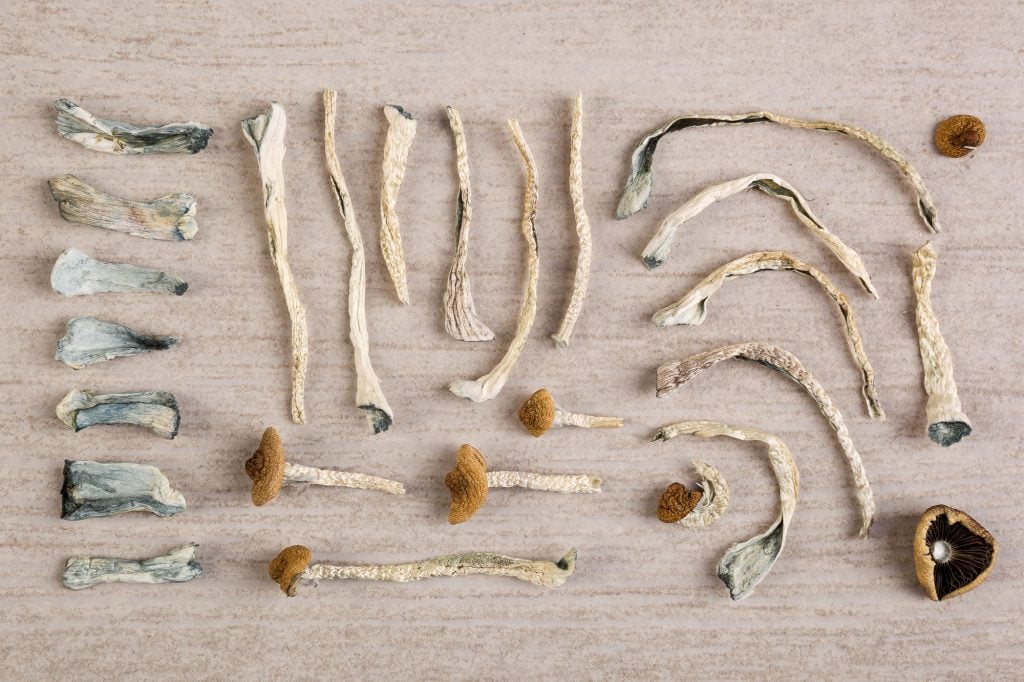
There Are Different Kinds of Magic Mushrooms
The most common species of magic mushrooms, by far, is Psilocybe cubensis.
Within the Psilocybe cubensis species, there are hundreds, if not thousands of magic mushroom strains found all around the world — all of which contain comparable concentrations of psilocybin or psilocin.
However, P. cubensis is far from the only species of mushroom to contain psychoactive doses. Here’s a quick breakdown of the many different kinds of magic mushrooms.
Doses of Magic Mushroom Species
| Psilocybe Species | Microdose | Standard Psychoactive Dose | Heroic Dose |
| Isolated (Pure) Psilocybin/Psilocin | 50 – 250 mcg | 6 – 18.5 mg | >31 mg |
| Psilocybe cubensis (0.62% Psilocybin) | 0.1 – 0.4 grams | 1–3 grams | 5+ grams |
| Psilocybe mexicana | N/A | N/A | N/A |
| Psilocybe azurescens (1.78% psilocybin) | <0.01 grams | 0.4 – 1.5 grams | 2+ grams |
| Psilocybe semilanceata | N/A | N/A | N/A |
| Psilocybe weilii (0.61% psilocybin) | 0.1 – 0.4 grams | 1–3 grams | 5+ grams |
| Psilocybe cyanescens (0.85 % psilocybin) | <0.3 grams | 0.7 – 2.2 grams | 3.5+ grams |
| Psilocybe baeocystis (0.85 % psilocybin) | <0.3 grams | 0.7 – 2.2 grams | 3.5+ grams |
| Psilocybe bohemica (1.34% psilocybin) | <0.2 grams | 0.5 – 1.5 grams | 2.5+ grams |
| Psilocybe tampanensis (0.68 % psilocybin) | <0.4 grams | 1–3 grams | 4.5+ grams |
Psilocybe azurescens
Psilocybe azurescens is the most potent known so far. It contains somewhere between 1.8% psilocybin by weight, as well as 0.5
psilocin and 0.5% baeocystin (a close relative of psilocybin).
These mushrooms are rare, but you can find them along the Western coast of North America. They’re especially abundant in wet, coastal regions of Oregon, Washington, and British Columbia.
Psilocybe baeocystis
Psilocybe baeocystis contains the highest concentration of the related alkaloid — baseocystin, as well as psilocybin.
The common name for these mushrooms is “knobby tops,” — which is in reference to the uneven or disfigured appearance of the mushrooms caps.
Psilocybe cubensis
Psilocybe cubensis is common and can be found on virtually every continent on earth, with the exception of Antarctica. These mushrooms are reliable in their effects and easy to grow at home yourself.
The concentration of psilocybin can vary from 0.6% of the dried weight to 1.2%. The most popular strain available today is Golden Teacher.
Psilocybe cyanescens
Psilocybe cyansecens is common — found on all continents on earth. It’s characterized by its “wavy’ appearance.
Archeologists have found depictions of what appears to be Psilocybe cyanescens on ancient Egyptian hieroglyphs.
The psilocybin content of these mushrooms is around 0.8% by dried weight.
Psilocybe mexicana
This species is famous for being the source Dr. Albert Hofman used to isolate psilocybin and psilocin for the very first time.
As the name implies, Psilocybe mexicana can be found primarily in Mexico and Central America. Locally, these mushrooms are referred to as teonanacatl. Throughout history, depictions of these mushrooms can be found on tombs, ornaments, and religious structures in Mesoamerica.
Psilocybe semilanceata
Psilocybe semilanceata are more commonly referred to as “Liberty Caps.” They can be found abundantly throughout most of North America in pastures and fields.
Unlike Psilocybe cubensis, this species doesn’t tend to grow out of manure.
These mushrooms are the second strongest, with approximately 1.28% psilocybin by dried weight.
Psilocybe weilii
Psilocybe weilii was named after Andrew Weil — a famous natural health specialist who made a lot of contributions to the field of psychotherapy research. He’s known for his regular contributions to High Times magazine and wrote the forward for Paul Stamet’s book — Psilocybin Mushrooms of the World.
The psilocybin content of these mushrooms is moderate at around 0.6%.
Magic Mushroom FAQs
1. Will Magic Mushrooms Make Me Fail A Drug Test?
Magic mushrooms are unlikely to show up on a drug test.
The elimination half-life of the active constituents of psychedelic mushrooms — psilocybin and psilocin — is very short. The vast majority of these compounds are no longer detectable in the blood or urine by the 24-hour mark.
The only test that can detect magic mushroom use more than 24–48 hours after taking them is a hair analysis test. However, hair drug testing is not common these days — especially for routine drug testing.
A hair analysis test may detect the presence of psilocin up to 90 days after it was used.
2. Is It Safe to Take Magic Mushrooms Alone?
Most experts don’t recommend taking magic mushrooms alone. Having a responsible (and trusted) trip sitter nearby is considered one of the pillars of responsible psychedelic use. When you’re under the influence of magic mushrooms, you become more vulnerable to harm (both accidental and malicious intent from others).
With that said, it is possible to trip alone safely. Some of the most famous psychonauts in history discuss the benefits of tripping solo.
If tripping alone, it’s important to pay extra intention to your set and setting. Minimize the chances of something going wrong as much as you can before you take the mushrooms.
3. What’s the Difference Between Psilocybin & Magic Mushrooms?
Psilocybin is the active ingredient in magic mushrooms. It can also be manufactured in a lab or isolated from the natural fungus.
Magic mushrooms contain a combination of psilocybin, psilocin, and baeocystin, which provide the psychoactive effects of the mushroom.
Psilocybin is metabolized to psilocin in the body, which is the primary active ingredient.
Some psychedelic mushrooms, such as the Amanita muscaria mushroom, don’t contain any psilocybin or psilocin and instead use an entirely different set of molecules to provide their psychedelic effects.
4. Is Psilocybin Addictive?
While it’s technically possible to form addictive tendencies around anything, it’s exceptionally rare with magic mushrooms.
First of all, the body forms a tolerance to magic mushrooms almost immediately. If you trip twice in a row, you’ll need a significantly higher dose for the second experience to feel anything at all. By the third or fourth dose, you’d need to take several times the regular dose to feel anything, and eventually, the effects will stop entirely.
Users need to wait about 1–2 weeks after a psychedelic mushroom experience for the tolerance to become reversed. This makes it very difficult to abuse magic mushrooms.
Secondly, there’s no indication that the body forms physical dependence on magic mushrooms, even with repeated use. This means if someone uses magic mushrooms habitually and then suddenly stops, they aren’t going to feel any withdrawal symptoms.
Withdrawal is one of the primary factors that drive addiction to substances like opiate drugs, cocaine, tobacco, and even caffeine.
5. Are Psilocybin Clinics Legal?
Yes, but only in select places.
For example, there are a few palliative care clinics currently operating in Canada that allow the medical use of psilocybin as an end-of-life treatment. They’re used to manage the existential anxiety and dread that follows a terminal diagnosis.
There are also some protocols being developed to use magic mushrooms for other conditions, including PTSD, depression, and addiction.
Magic mushrooms are becoming decriminalized in an increasing number of countries and cities around the world — but this doesn’t mean psilocybin clinics are legal here.
Also see: Psychedelic Directory: Courses, Retreats, Clinics, & Communities.
6. What’s The Difference Between Decriminalization & Legalization?
Decriminalization and legalization both involve a relaxation of existing laws covering a specific substance or activity — but there are some key differences.
Decriminalization refers to the removal of criminal charges for committing a certain crime — but it’s still illegal. When caught in possession of a decriminalized substance, the punishments usually involve confiscation and a fine. These changes are usually implemented to reduce the burden of non-violent drug crimes from clogging up the justice system. It’s also used as a way to prevent people with substance abuse disorders from being able to find effective treatment.
Legalization involves the complete elimination of penalties from using or possessing a substance that was previously prohibited. It also enables the commercial sale of a given substance. There are often restrictions in place for legalized substances.
Sometimes substances are legalized for medical use only (such as marijuana, MDMA, and ketamine), other times the quantities and age limits are regulated.
7. How Much Do Magic Mushrooms Cost?
The cost of magic mushrooms will vary depending on where you live, but in general, a single gram of psychedelic shrooms can range from $7 to $12.
In places where shrooms are legal or decriminalized, they’re usually cheaper, while places with strict regulations tend to be more expensive. This is due to the laws of supply and demand.
Growing magic mushrooms yourself is the cheapest way to source them if you use magic mushrooms often. The initial cost to setup a magic mushroom grow can range from $50 and up depending on how large and technical you want to make it. However, even very cheap setups can produce copious amounts of mushrooms for years to come with minimal maintenance costs.
8. Do Magic Mushrooms Expire?
Yes, magic mushrooms will expire if they aren’t used in time.
Fresh mushrooms have the shortest shelf-life, lasting just a few days if kept in the fridge before going bad.
Dried shrooms will last much longer — up to 12 months before they start to degrade. It’s unlikely for dried shrooms to rot within this amount of time, but the potency will start to drop off significantly after 6 months at room temperature, and about a year in the fridge.
For long-term storage of magic mushrooms, consider keeping them in a vacuum-sealed bag in the freezer, or converting them into psilocybin honey.
9. Can You Smoke Magic Mushrooms?
No, it’s not a good idea to smoke magic mushrooms. Not only will the heat destroy the active constituents (rendering them useless), but they can cause damage and irritation to the lungs.
What Does the Future Look Like For Magic Mushrooms?
As public interest in the use of magic mushrooms continues to grow, there’s a growing push to legalize the use of psilocybin-containing mushrooms for therapeutic use.
There have already been a few cities in the United States that have decriminalized the use of magic mushrooms, as well as the entire state of Oregon.
Other regions around the world are following suit in light of the overwhelmingly positive results being published on the safety and efficacy of magic mushrooms.
Within a few years, it’s likely magic mushrooms will be widely available by the public. Psychotherapy clinics centered around the use of magic mushrooms as therapy are also likely to become more mainstream within the next decade. These clinics are well-suited for treating chronic depression, anxiety, addiction, and existential crises.
Subscribe To Get a Weekly Dose of Psychedelics In Your Inbox 🌈 🍄 🐍 🧠
References
- Carhart-Harris, R. L., Roseman, L., Bolstridge, M., Demetriou, L., Pannekoek, J. N., Wall, M. B., … & Leech, R. (2017). Psilocybin for treatment-resistant depression: fMRI-measure brain mechanisms. Scientific reports, 7(1), 1-11.
- Davis, A. K., Barrett, F. S., & Griffiths, R. R. (2020). Psychological flexibility mediates the relations between acute psychedelic effects and subjective decreases in depression and anxiety. Journal of Contextual Behavioral Science, 15, 39-45.
- Hasler, F., Grimberg, U., Benz, M. A., Huber, T., & Vollenweider, F. X. (2004). Acute psychological and physiological effects of psilocybin in healthy humans: a double-blind, placebo-controlled dose-effect study. Psychopharmacology, 172(2), 145-156.
- Griffiths, R. R., Richards, W. A., McCann, U., & Jesse, R. (2006). Psilocybin can occasion mystical-type experiences having substantial and sustained personal meaning and spiritual significance. Psychopharmacology, 187(3), 268-283.
- Cerletti, A. U. R. É. L. I. O. (1958). Étude pharmacologique de la psilocybine. Les champignons hallucinogènes du Mexique. Paris: Muséum d’histoire naturelle, 268-71.
- Schindler, E. A., Gottschalk, C. H., Weil, M. J., Shapiro, R. E., Wright, D. A., & Sewell, R. A. (2015). Indoleamine hallucinogens in cluster headache: results of the Clusterbusters medication use survey. Journal of psychoactive drugs, 47(5), 372-381.
- Celada, P., Puig, M. V., Amargós-Bosch, M., Adell, A., & Artigas, F. (2004). The therapeutic role of 5-HT1A and 5-HT2A receptors in depression. Journal of Psychiatry and Neuroscience, 29(4), 252.
- Shelton, R. C., Sanders-Bush, E., Manier, D. H., & Lewis, D. A. (2009). Elevated 5-HT 2A receptors in the prefrontal cortex in major depression are associated with reduced activity of protein kinase A. Neuroscience, 158(4), 1406-1415.
- Carhart-Harris, R. L., Bolstridge, M., Rucker, J., Day, C. M., Erritzoe, D., Kaelen, M., … & Taylor, D. (2016). Psilocybin with psychological support for treatment-resistant depression: an open-label feasibility study. The Lancet Psychiatry, 3(7), 619-627.
- Grob, C. S., Danforth, A. L., Chopra, G. S., Hagerty, M., McKay, C. R., Halberstadt, A. L., & Greer, G. R. (2011). Pilot study of psilocybin treatment for anxiety in patients with advanced-stage cancer. Archives of general psychiatry, 68(1), 71-78.
- Griffiths, R. R., Johnson, M. W., Carducci, M. A., Umbricht, A., Richards, W. A., Richards, B. D., … & Klinedinst, M. A. (2016). Psilocybin produces substantial and sustained decreases in depression and anxiety in patients with life-threatening cancer: A randomized, double-blind trial. Journal of psychopharmacology, 30(12), 1181-1197.
- Bogenschutz, M. P., Forcehimes, A. A., Pommy, J. A., Wilcox, C. E., Barbosa, P. C. R., & Strassman, R. J. (2015). Psilocybin-assisted treatment for alcohol dependence: a proof-of-concept study. Journal of psychopharmacology, 29(3), 289-299.
- Johnson, M. W., Garcia-Romeu, A., Cosimano, M. P., & Griffiths, R. R. (2014). Pilot study of the 5-HT2AR agonist psilocybin in the treatment of tobacco addiction. Journal of psychopharmacology, 28(11), 983-992.
- Fadiman, J., & Korb, S. (2019). Might microdosing psychedelics be safe and beneficial? An initial exploration. Journal of psychoactive drugs, 51(2), 118-122.

